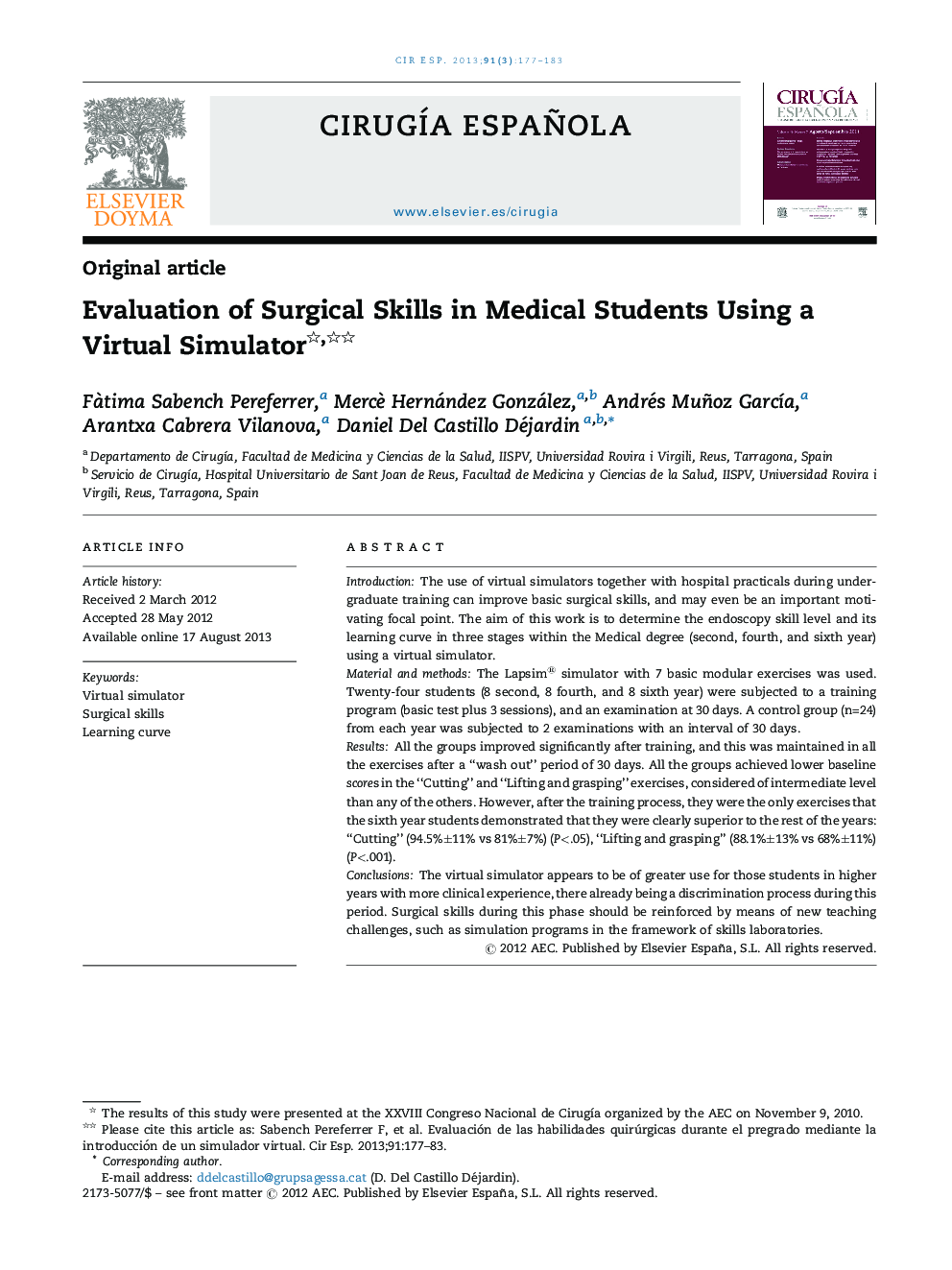| کد مقاله | کد نشریه | سال انتشار | مقاله انگلیسی | نسخه تمام متن |
|---|---|---|---|---|
| 4255523 | 1284457 | 2013 | 7 صفحه PDF | دانلود رایگان |

IntroductionThe use of virtual simulators together with hospital practicals during undergraduate training can improve basic surgical skills, and may even be an important motivating focal point. The aim of this work is to determine the endoscopy skill level and its learning curve in three stages within the Medical degree (second, fourth, and sixth year) using a virtual simulator.Material and methodsThe Lapsim® simulator with 7 basic modular exercises was used. Twenty-four students (8 second, 8 fourth, and 8 sixth year) were subjected to a training program (basic test plus 3 sessions), and an examination at 30 days. A control group (n=24) from each year was subjected to 2 examinations with an interval of 30 days.ResultsAll the groups improved significantly after training, and this was maintained in all the exercises after a “wash out” period of 30 days. All the groups achieved lower baseline scores in the “Cutting” and “Lifting and grasping” exercises, considered of intermediate level than any of the others. However, after the training process, they were the only exercises that the sixth year students demonstrated that they were clearly superior to the rest of the years: “Cutting” (94.5%±11% vs 81%±7%) (P<.05), “Lifting and grasping” (88.1%±13% vs 68%±11%) (P<.001).ConclusionsThe virtual simulator appears to be of greater use for those students in higher years with more clinical experience, there already being a discrimination process during this period. Surgical skills during this phase should be reinforced by means of new teaching challenges, such as simulation programs in the framework of skills laboratories.
ResumenIntroducciónDurante el pregrado, la utilización de los simuladores virtuales junto con las prácticas hospitalarias puede mejorar las aptitudes quirúrgicas básicas, e incluso ser un eje motivacional importante. El objetivo del trabajo es determinar el grado de habilidad endoscópica y su curva en 3 etapas dentro del grado de Medicina (segundo, cuarto y sexto curso) mediante un simulador virtual.Material y métodosSe ha utilizado el simulador Lapsim® con 7 ejercicios del módulo básico. Se somete a 24 alumnos (8 de segundo, 8 de cuarto y 8 de sexto curso) a un programa de entrenamiento (prueba basal más 3 sesiones) y a un examen a los 30 días. Un grupo control de cada curso (n = 24) ha sido sometido a 2 exámenes con un intervalo de 30 días.ResultadosTodos los grupos mejoran significativamente después del entrenamiento y se mantienen después del periodo de lavado de 30 días, y en todos los ejercicios. Los ejercicios «Cutting» y «Lifting and grasping», considerados de nivel intermedio, destacan sobre los demás por el bajo score basal que tienen todos los grupos. Después del proceso de entrenamiento, en cambio, son los únicos ejercicios en los que los alumnos de sexto se muestran claramente superiores respecto a los demás cursos: «Cutting» (94,5% ± 11 vs 81% ± 7) (p < 0,05), «Lifting and grasping» (88,1% ± 13 vs 68% ± 11) (p < 0,001).ConclusionesLa utilidad del simulador virtual parece mayor para aquellos alumnos de cursos superiores con una mayor experiencia clínica, existiendo un proceso de discriminación ya durante este periodo. Las competencias quirúrgicas durante esta fase deberían reforzarse mediante nuevas apuestas docentes como los programas de simulación en el marco de los laboratorios de habilidades.
Journal: Cirugía Española (English Edition) - Volume 91, Issue 3, March 2013, Pages 177–183